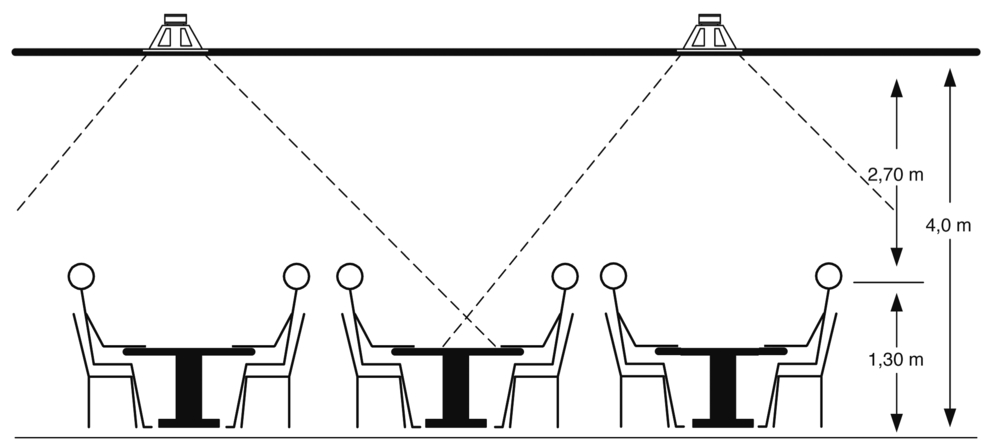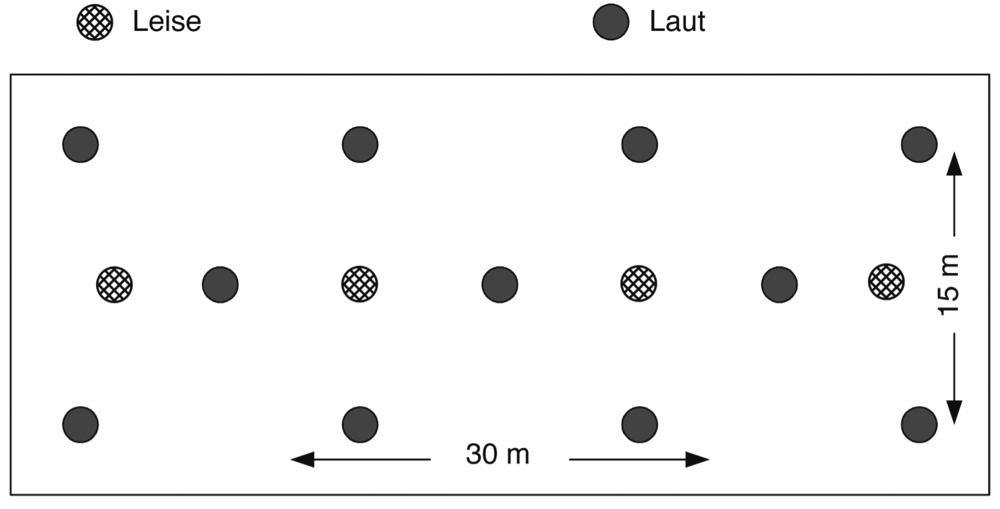
Planning PA applications with ceiling speakers: basic knowledge of coverage and selection
There are 3 things planners and installers should know and take into account
Selection and positioning of the right PA technology is not always that easy, particularly if the electrician or installer does not specialise in PA technology or has not often planned a PA system yet. However, a PA application with ceiling speakers can totally change a room's ambience. We provide you with some basic rules which will help you to ensure a better and more precise implementation of your PA projects.
Selecting number and position of ceiling speakers: a quick guide
There is a formula for positioning ceiling speakers which determines the approximate grid dimension, i.e. distances between speakers:
(ceiling height - ear level) x 2 = grid dimension.
When a person is seated, their ear is approximately 1.30 metres above the floor. Our example shows a ceiling height of 4 metres. This results in the following calculation: (4 metres - 1.30 metres) x 2 = a grid dimension of 5.40 metres. These 5.40 metres are the perfect grid dimension for flush-mount ceiling speakers, i.e. there is a distance of 5.40 metres in width and depth between the ceiling speakers. Thus, you can use the size of the room and determine the approximate number of speakers you require.
Hence, if you use ceiling speakers for a PA application, the ceiling height will be in proportion to seated people and you achieve a consistent sound radiation in the room. So do not be afraid to equip an object with many ceiling speakers, because:
Hence, if you use ceiling speakers for a PA application, the ceiling height will be in proportion to seated people and you achieve a consistent sound radiation in the room. So do not be afraid to equip an object with many ceiling speakers, because:
Using many quieter speakers will lead to better results, regardless of room and application. Do not try to lower costs by installing only a few yet very loud speakers.
The proper volume for ceiling speakers
If you use fewer speakers on a high volume, the overall sound will not be pleasant anymore. Ultimately, ceiling speakers are supposed to 'paint a soundscape' instead of providing direct, penetrating sound such as a PA system which is devised for direct music reproduction.
If it is otherwise difficult to adhere to the grid dimension, you can use different speakers on varying volumes to achieve an optimum sound. You can realize this by using amplifiers which allow for such a grouping of speakers. For instance, you can equip 450 square metres with 15 speakers. The loud speakers 'frame' the room while the quiet ones fill in spaces.
If it is otherwise difficult to adhere to the grid dimension, you can use different speakers on varying volumes to achieve an optimum sound. You can realize this by using amplifiers which allow for such a grouping of speakers. For instance, you can equip 450 square metres with 15 speakers. The loud speakers 'frame' the room while the quiet ones fill in spaces.
General rule: big speakers provide good sound in large rooms. On the other hand, very big speakers in small areas are not recommended. Is the room particularly small? Then one pair of speakers is enough and you do not have to use 100 V line technique.
Full range speakers or 2-way speakers?
Full range speakers are considered all-rounders among speakers. They are able to reproduce almost the complete frequency range of human hearing. These speakers manage the split between good tweeter reproduction and good bass reproduction. However, this results in corresponding shortcomings in the sound quality. For bass reproduction, a large cone area and excursion are required, while tweeter reproduction requires a small and light cone. In addition, the larger the diameter of the cone, the more decreases the radiation angle at high frequencies. Standard full range speakers are mainly used for speech reproduction or unobtrusive background music.
In contrast, the frequency range in a 2-way system is divided between two sound converters. Thus, users can apply special systems that are optimised for their particular range of application. A tweeter reproduces the high frequencies (from approx. 1,500-3,500 Hz on), while a bass-midrange speaker reproduces bass frequencies and midrange frequencies. Thereby, you get a reproduction of the full frequency range and a rich and detailed sound. 2-way speakers are usually used for high-quality music reproduction but also for speech reproduction or mixed PA applications.
The 2-group principle for ceiling speakers in multi-purpose rooms
Group 1:
Flush-mount (ceiling) speakers generate a quiet, indirect soundscape. These speakers radiate expanding sound from the ceiling onto visitors. There is a good reason why they usually are mono speakers. A stereo signal would create muddled sound situations in a soundscape because you as the planer would not be able to stick to the correct positioning of right and left speakers.
Group 2:
Surface-mount speakers provide a louder and more direct sound. Especially with surface-mount speakers, make sure they are evenly distributed in the room. Since the sound radiation of surface-mount speakers does not expand evenly downwards but instead has a specific radiation direction, you have to be careful when distributing them. Does a surface-mount speaker radiate in the direction of guests or users close by? Nobody likes to sit in a café or a lounge close to a surface-mount speaker which is too loud. However, there are other criteria for deciding whether to use surface-mount speakers or flush-mount speakers, e.g. given mounting options or visual unobtrusiveness.
If you follow these tips, making the right choices when planning a PA system with ceiling speakers may be easier. Sometimes it is helpful, too, to refresh your basic knowledge. If you want to know more about planning PA systems, we have some tips for you.
You do not specialise in PA projects but would like to know more about the field? Your Project is Our Project. This is why we compiled basic knowledge of 100 V line technique.
Image source headergrafic: wutzkoh – stock.adobe.com



